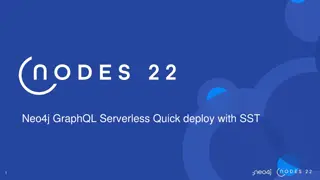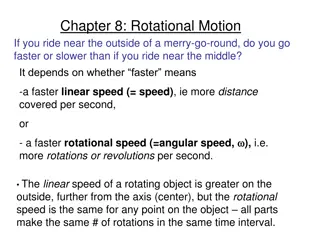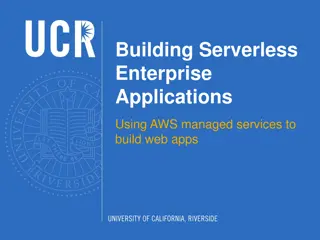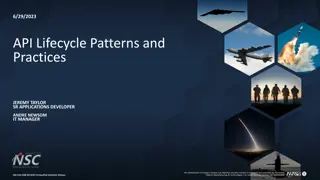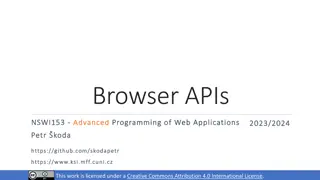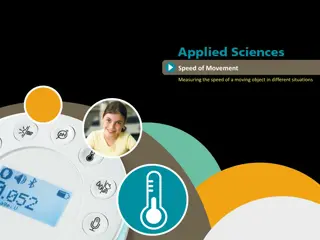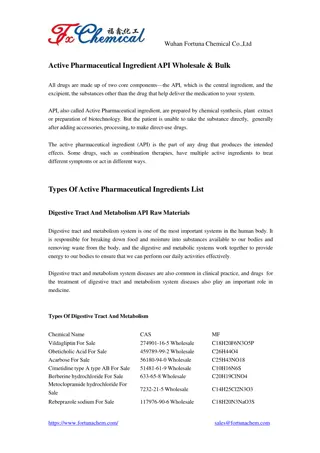
Serverless Functions and APIs Designing for Speed and Scale
As businesses shift toward more agile and efficient cloud solutions, serverless architecture has emerged as a powerful tool for building scalable and fast applications.
Download Presentation

Please find below an Image/Link to download the presentation.
The content on the website is provided AS IS for your information and personal use only. It may not be sold, licensed, or shared on other websites without obtaining consent from the author. Download presentation by click this link. If you encounter any issues during the download, it is possible that the publisher has removed the file from their server.
E N D
Presentation Transcript
Serverless Functions and APIs: Designing for Speed and Scale As businesses shift toward more agile and efficient cloud solutions, serverless architecture has emerged as a powerful tool for building scalable and fast applications. In particular, serverless functions and APIs provide developers with the flexibility to create highly responsive, scalable applications without the need to manage infrastructure. By leveraging serverless functions and APIs, businesses can build and deploy services faster, while ensuring they can scale effortlessly to meet demand. What Are Serverless Functions? Serverless functions, also known as Functions-as-a-Service (FaaS), are small, single-purpose pieces of code that run in response to specific events, such as HTTP requests, database changes, or scheduled triggers. Unlike traditional server-based environments, serverless functions do not require developers to manage servers or worry about capacity planning. Cloud providers like AWS Lambda, Google Cloud Functions, and Azure Functions handle the provisioning, scaling, and execution of the code. These functions are ideal for lightweight tasks that can be executed quickly, allowing developers to focus on code and business logic rather than infrastructure management. This event-driven nature makes serverless functions particularly well-suited for building APIs. What Are Serverless APIs? A serverless API is an interface built using serverless functions to handle HTTP requests, providing a lightweight, scalable way to interact with an application. APIs are the backbone of modern applications, enabling communication between different software components or services. When integrated with serverless functions, APIs become more efficient, automatically scaling based on the number of requests and handling peaks in traffic seamlessly. Popular platforms like Amazon API Gateway, Azure API Management, and Google Cloud Endpoints work hand-in-hand with serverless functions to create robust, scalable APIs without the need to manage underlying servers. Designing Serverless Functions and APIs for Speed and Scale 1.Event-Driven Architecture The core advantage of serverless functions lies in their event-driven nature. This means that functions are only executed in response to specific triggers or events, such as an API request or a file upload. This architecture eliminates the need for always-on servers, which not only reduces costs but also enables better resource management. The system scales based on the number of incoming events, ensuring that no resources are wasted when traffic is low, and that the application can handle high traffic volumes without manual intervention. 2.Automatic Scaling One of the most attractive features of serverless architecture is automatic scaling. Serverless platforms scale functions automatically in response to demand. Whether the API is processing one request or thousands per second, the cloud provider dynamically allocates the required resources. This eliminates
the risk of downtime during traffic surges and ensures that users experience consistent performance, regardless of demand. For example, an e-commerce site using serverless APIs for customer searches can handle sudden traffic spikes during a sale without any manual scaling effort. 3.Faster Development and Deployment Serverless functions and APIs significantly speed up development cycles. Developers no longer need to worry about server management, load balancing, or scaling strategies. This allows teams to focus on writing code and deploying applications faster. Moreover, serverless functions are modular, meaning individual components can be updated or deployed without affecting the entire system, making continuous deployment easier and more efficient. Serverless APIs also benefit from this flexibility. With frameworks like AWS API Gateway and Azure API Management, developers can quickly create, test, and deploy APIs that integrate seamlessly with serverless functions. 4.Cost Efficiency Serverless functions and APIs follow a pay-as-you-go pricing model, which means you only pay for the actual compute time used by the functions. In contrast to traditional server-based architectures, where resources must be provisioned and paid for upfront regardless of usage, serverless ensures that businesses are only charged when their functions are actively running. For example, in a traditional setup, you might pay for an entire server 24/7, even when it s only handling requests a fraction of the time. In serverless, you're charged only when your API is invoked, making it a much more cost-efficient solution. Best Practices for Designing Serverless APIs and Functions 1.Keep Functions Small and Focused Serverless functions should be designed to perform single tasks efficiently. This keeps execution times low, improves maintainability, and allows for faster deployment. For instance, a function handling user authentication should be separate from one processing payments. 2.Implement Caching Use caching for API responses to reduce the need for repeated function invocations. Cached data improves performance and reduces costs by limiting the number of function executions. 3.Monitor and Optimize Performance Serverless platforms offer built-in monitoring tools to track performance and usage. By monitoring metrics like execution time, errors, and cold start frequency, developers can optimize their functions to reduce latency and enhance user experience. Conclusion Serverless functions and APIs are transforming the way applications are built and scaled, offering speed, flexibility, and efficiency. With automatic scaling, cost efficiency, and rapid deployment, serverless architecture empowers businesses to create fast, scalable applications without the complexity of
managing infrastructure. As more businesses adopt cloud-native strategies, serverless functions and APIs will play a crucial role in shaping the future of scalable, high-performance applications. Read designing.html More: https://techhorizonsolutions.blogspot.com/2024/09/serverless-functions-and-apis-


